Key takeaways:
- Breakdancing is a community-driven art form that emphasizes connection, camaraderie, and honoring its historical roots.
- Understanding judging criteria is crucial; creativity and style matter as much as technical execution in performances.
- Building relationships with judges can enhance performance feedback and open doors to new opportunities in the breakdancing journey.
- Engaging with judges through personal stories and active listening fosters meaningful connections and enriches the competition experience.
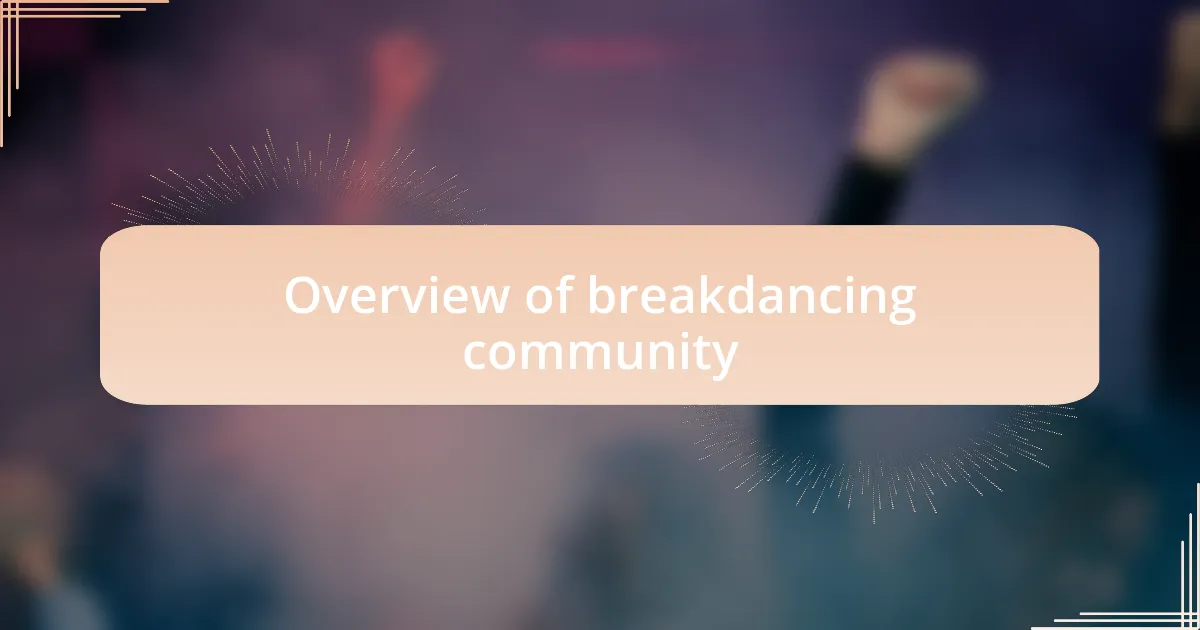
Overview of breakdancing community
The breakdancing community is a vibrant tapestry woven from diverse backgrounds and experiences. I remember walking into my first cypher, feeling both exhilarated and intimidated. The energy was electric, each dancer telling their story through movement, and it made me realize how universal this art form truly is.
At its core, breakdancing isn’t just about the moves; it’s about connection. Have you ever felt the thrill of sharing a circle with strangers who become friends through rhythm? That camaraderie extends beyond the dance floor, forging bonds that often last a lifetime, and it’s this element that gives the community its heart and soul.
As the breakdancing scene continues to grow and evolve, there is a palpable sense of responsibility among the dancers to honor its roots. I often find myself reflecting on the rich history of this dance, feeling a deep respect for the pioneers who paved the way. This awareness helps unite us, reminding us that we’re part of something much bigger than ourselves.
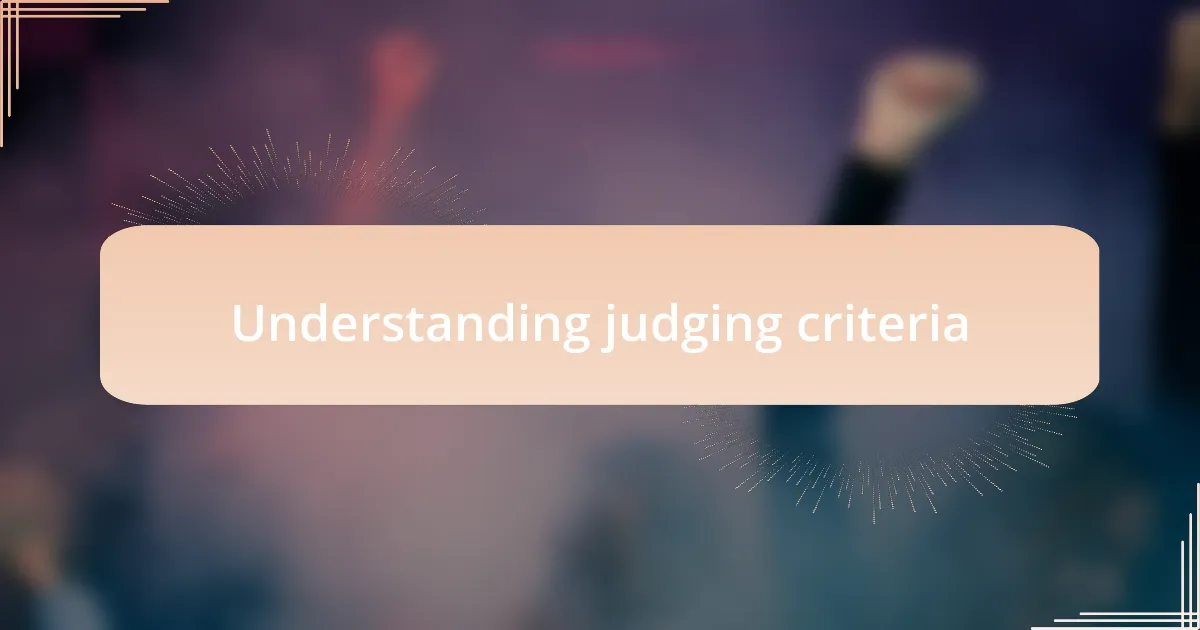
Understanding judging criteria
Understanding the judging criteria in breakdancing can profoundly impact your performance. I recall a competition where I focused solely on my moves, only to realize afterward that judges were looking for creativity and style as much as execution. Have you ever experienced that disconnect between what you thought they wanted and what they actually valued?
Judges typically assess multiple aspects, including technique, originality, and musicality. It’s fascinating to see how my own interpretation of a beat shapes my movement, and this is precisely the kind of personal touch judges are often eager to see. When I embraced improvisation and let the music guide me, my scores improved significantly.
Ultimately, understanding how judges think can shift your approach to dancing. By aligning your performance with their criteria—while still staying true to your unique voice—you create a powerful blend. Isn’t it rewarding when you not only please the judges but also express your authentic self on the dance floor?

Importance of networking with judges
Building relationships with judges is a game-changer in the breakdancing world. I remember attending a workshop where a judge shared insights on the importance of connecting with competitors. Listening to their feedback not only improved my skills but also helped me understand the subtle nuances they value in performances. How often do we overlook these opportunities to engage?
Networking with judges allows you to gain insights that can inform your dancing style. Once, I took a moment after a competition to chat with a judge about my routine. Their perspective opened my eyes to how small tweaks could make a significant difference. It felt like having a mentor guiding me towards personal growth in my craft.
Moreover, establishing rapport with judges can create a lasting impression. I’ve seen dancers who made an effort to connect beyond the stage receive more constructive critiques later on. Isn’t it inspiring to think that building those relationships could enhance not just your performance, but your entire journey in the breakdancing community?
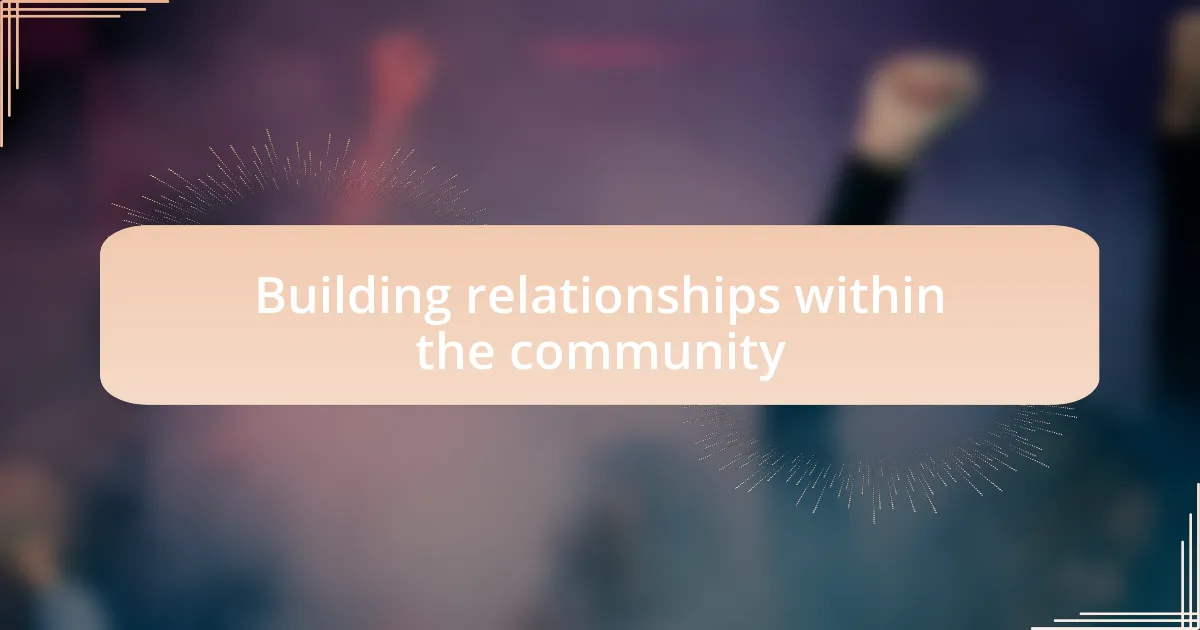
Building relationships within the community
Building relationships within the breakdancing community starts with simple interactions. I recall when I complimented a judge on their feedback during a regional battle—this sparked a genuine conversation about what they look for in performances. That moment taught me that a few kind words could open doors to deeper discussions about artistry and technique, turning a simple exchange into a valuable connection. When was the last time you reached out to someone in the community?
Participating in workshops not only hones your skills but also strengthens your ties with judges and fellow dancers. After a recent session, I found myself sitting next to a judge during lunch. As we talked about our favorite breakdancing styles, I realized how shared passions can bridge gaps and foster relationships. It was a reminder that connecting with others in the community can feel refreshingly effortless and rewarding.
Additionally, nurturing these relationships often leads to unexpected opportunities. There was a time when a judge I had built rapport with invited me to perform at a local event, recognizing my growth and passion. That invitation was more than just a gig; it was a validation of my hard work and a testament to how supportive connections can change your trajectory in breakdancing. Have you ever considered how powerful these connections can be for your journey?
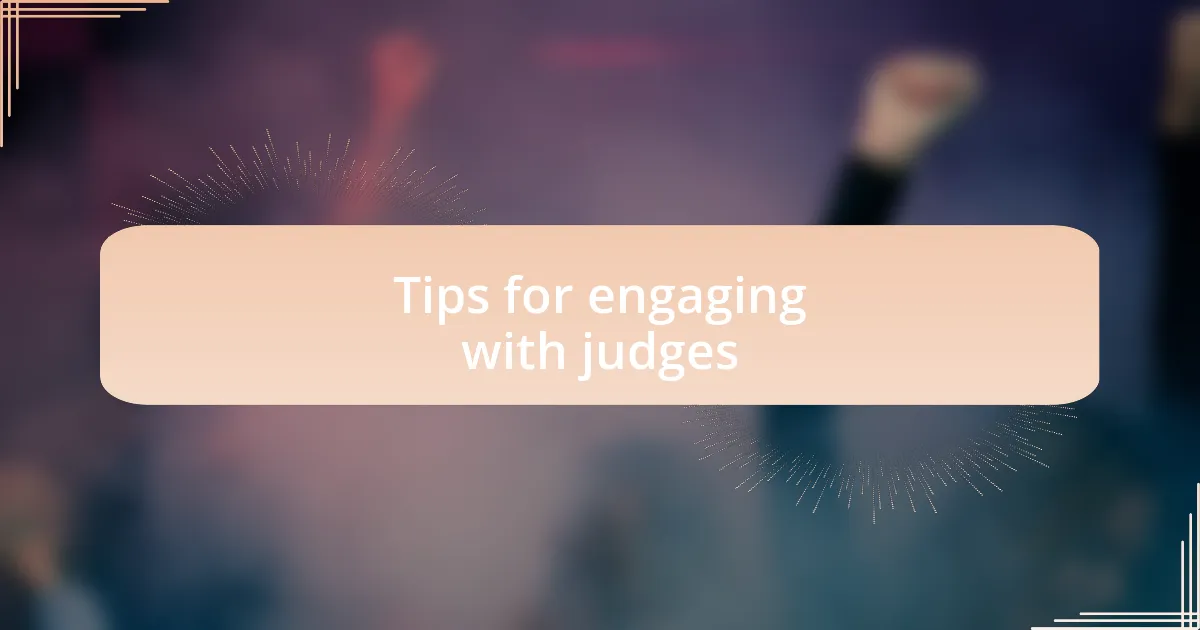
Tips for engaging with judges
Engaging with judges goes beyond just showcasing your skills; it’s also about making meaningful connections. I remember during a competition, I made it a point to introduce myself to a judge beforehand, sharing a bit about my background and aspirations. That simple interaction made me feel more at ease during my performance and allowed the judge to see me not just as a competitor, but as a passionate dancer eager to learn. How have you positioned yourself to create that connection with judges?
Emphasizing active listening can be a game changer when interacting with judges. During feedback sessions, I make sure to ask clarifying questions about their critiques, showing that I genuinely value their insights. One time, after receiving feedback on my moves, I asked how I could improve my footwork. The judge appreciated my eagerness to learn, which led to a longer conversation about advanced techniques. Have you thought about what kind of questions could lead you to richer insights from judges?
Finally, showing appreciation for judges’ time can foster stronger relationships. I once took a moment after a competition to personally thank a judge for their thoughtful feedback. My gratitude led to a conversation about their judging process and experiences, reminding me that these figures in our community are just as passionate as we are. Have you taken the time to express your thanks to judges? Small gestures like this can transform a one-time interaction into a lasting connection.
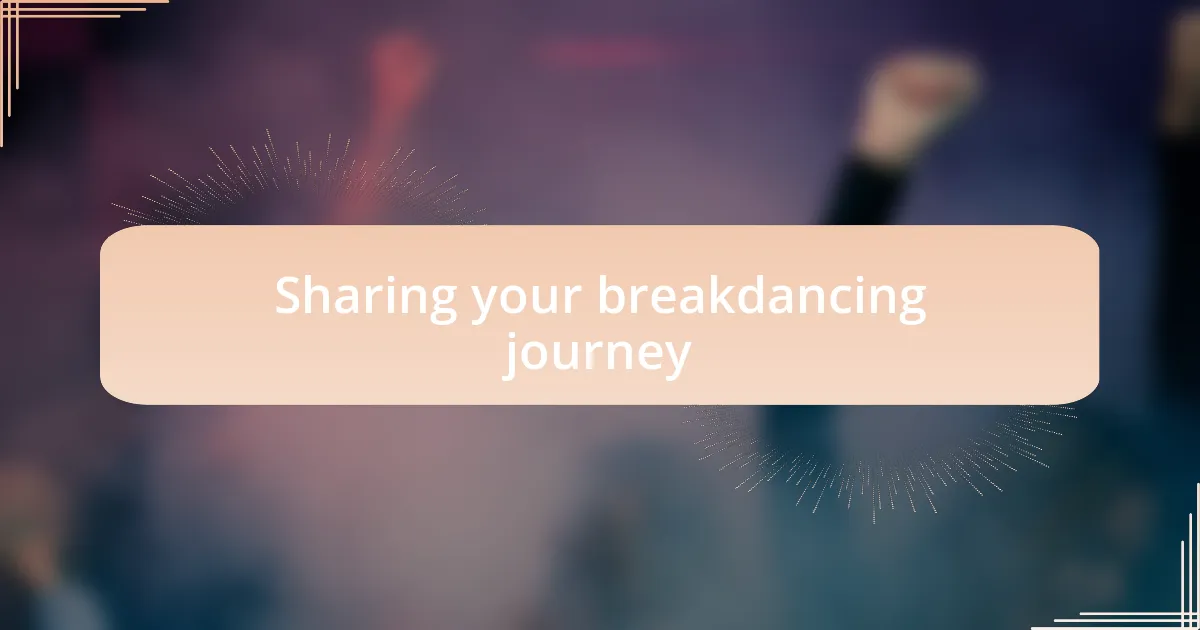
Sharing your breakdancing journey
Sharing your breakdancing journey with judges can truly enrich the competition experience. I recall a time when I shared how I transitioned from a casual dancer to a competitor. It was exhilarating to see the judges nodding in understanding, as if they resonated with my struggles and triumphs. Have you ever thought about how your unique story might also inspire others in the dance community?
I believe that weaving personal anecdotes into your interactions can make a significant impact. Once, during a preliminary round, I mentioned how I trained to overcome my fear of performing in front of others. The judges not only appreciated my honesty, but it also sparked a conversation about the importance of mental resilience in dance. How often do we reflect on the emotional aspects of our journey when engaging with judges?
It’s vital to connect on a personal level, not just about the dance itself but the life behind it. At one competition, I shared my experiences with adjusting my style to fit different genres. The look of intrigue and recognition on the judges’ faces was unforgettable, reminding me that every dancer has a story worth telling. What aspects of your journey do you think could resonate with judges and create a deeper connection?
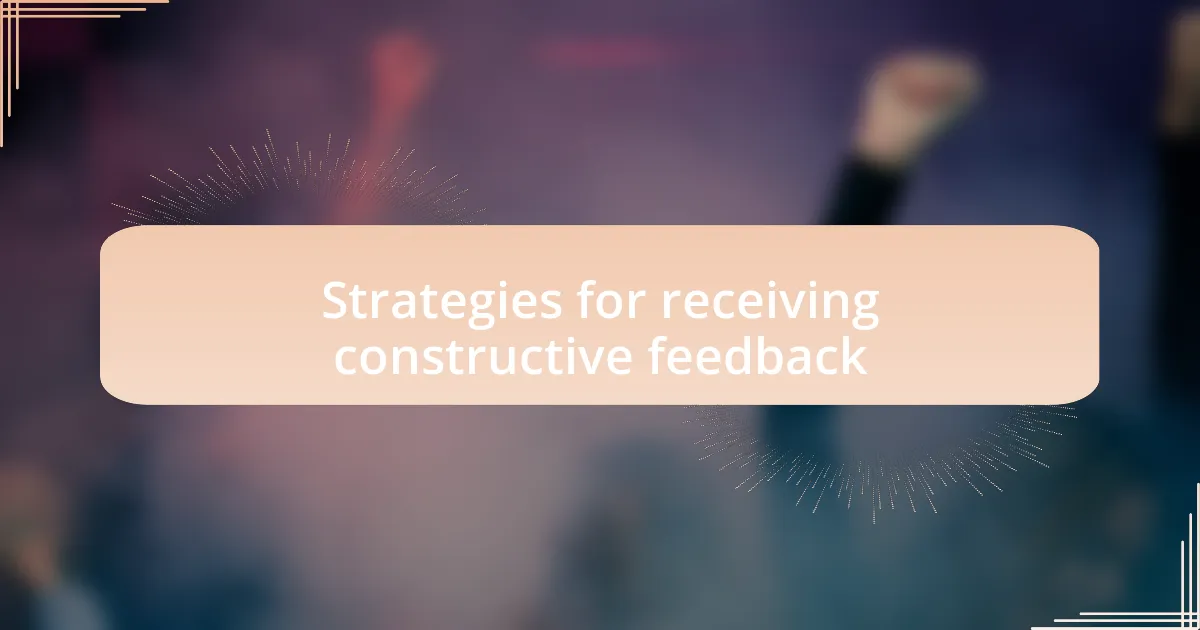
Strategies for receiving constructive feedback
When it comes to receiving constructive feedback, I find that maintaining an open mindset is crucial. One time, after a performance, a judge pointed out a few techniques that needed improvement. Instead of getting defensive, I took a deep breath and listened carefully. It was surprising how the feedback sharpened my focus on what I needed to work on. Have you ever felt that nervousness but then realized the value in constructive criticism?
Another effective strategy is to ask specific questions when soliciting feedback. For instance, during a workshop, I asked a judge about my spin technique, hoping for insight. Their detailed response not only clarified my doubts but also opened avenues for further discussion. This kind of interaction can help you gain clarity, contributing significantly to your growth as a dancer. How often do you take the initiative to dive deeper into the feedback you receive?
Lastly, I’ve learned the importance of reflecting on the feedback after the event. Immediately after a competition, I write down what the judges said and how I felt about it. Just a few days later, looking back at my notes, I often find patterns in their suggestions that I might have overlooked in the heat of the moment. Do you ever give yourself that reflective time, allowing the feedback to settle in and guide your practice?